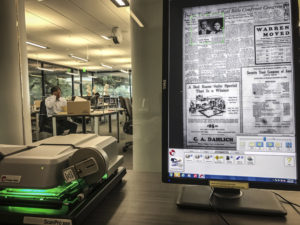Frozen At The Briscoe Center
AUSTIN — This is my first trip to the Briscoe Center for American History on the UT campus since its renovation, the first phase of which was completed last spring. I walked in, eager to peruse some newspaper microfilm after admiring the new gallery. After signing in, I entered the reading room. I noticed that the three employees behind the counter, who retrieve materials from the mysterious bowels of thi s accclaimed repository, were dressed as if a blizzard was imminent. They wore hoodies or thick sweaters, gloves without tips to allow typing, and winter hats. It was 96 degrees outside, 60 degrees in the reading room.
s accclaimed repository, were dressed as if a blizzard was imminent. They wore hoodies or thick sweaters, gloves without tips to allow typing, and winter hats. It was 96 degrees outside, 60 degrees in the reading room.
I ran across one of the folks who has worked at the Briscoe forever, where I’m a familiar face after 35 years of doing research here. “Sure is cold in here,” I remarked. She explained that the contractors were revamping the heating/cooling system on the second and third floors, and while that was happening it was impossible to mix warm air with cold to regulate the temperature. I was utterly unprepared, in shorts, T-shirt and sandals. At least there was no chance of getting sleepy, though every 30 minutes I went outside to revel in the nearly three-digit temps. That does not happen very often to someone who despises summer in Texas.
I decided, at random, to start looking at microfilms of the Austin American starting on New Year’s Day of 1930. No reason, other than I woke up and decided to see what was going on in 1930.
- One of the front-page headlines claimed a “Cache of Fortune in Gold Stolen Years Ago Rumored Near Border of Texas.” Seems the ranch of the late George B. Christian, south of San Antonio, had buried treasure. Christian was reported to have died while out on bond on a charge of writing obscene letters to his brother, with whom he was on the outs. Supposedly, $2.4 million in gold was buried on his ranch. He had disappeared and spent time south of the border where he “entertained Mexican plutocrats and alluring señoritas.” Now that he had passed, treasure hunters were on the prowl.
- In Austin, a former appeals court judge was about to go to trial for stabbing a court stenographer to death, a story that dominated the newspaper for several months. John W. Brady was more than twice as old as the young woman. He was married, and reportedly a serious alcoholic. The writer danced around whether Brady and the young woman were romantically involved. Brady’s wife ultimately testified to her husband’s fondness for strong drink.
- Prohibition was still in effect in 1930, and a feud between competing bootleggers in Goldwaithe, west of Waco, led to a shootout that left one man dead. Illicit drinking appeared to be so commonplace as to be hardly newsworthy, considering the alcoholic judge mentioned above and other news items I found.
- Texas seems to have been a rather violent place in 1930, though that perception could be a result of what the newspaper chose to publish. Much as local television these days has adopted the credo of, “If it bleeds, it leads,” the fatal shooting of a husband by his wife in Waco, after they quarreled all day over a 15-cent ice bill, made it onto the front page. She wanted him to pay, he refused, and she plugged him in the back. She then chased the maid out into the backyard but the woman escaped without injury.
- A wicked cold front swept through the state the second week of January, resulting in at least eight deaths. A man walking the highway, described as a soldier of fortune, developed frostbite and was likely to lose both his feet, the story reported.
Meanwhile, I kept going outside and stamping my feet to get circulation going. The frigid air-conditioning was not cold enough for frostbite to be a risk, but I sure wish I had brought a jacket.
Who knew?
Leave a reply
Fields marked with * are required











